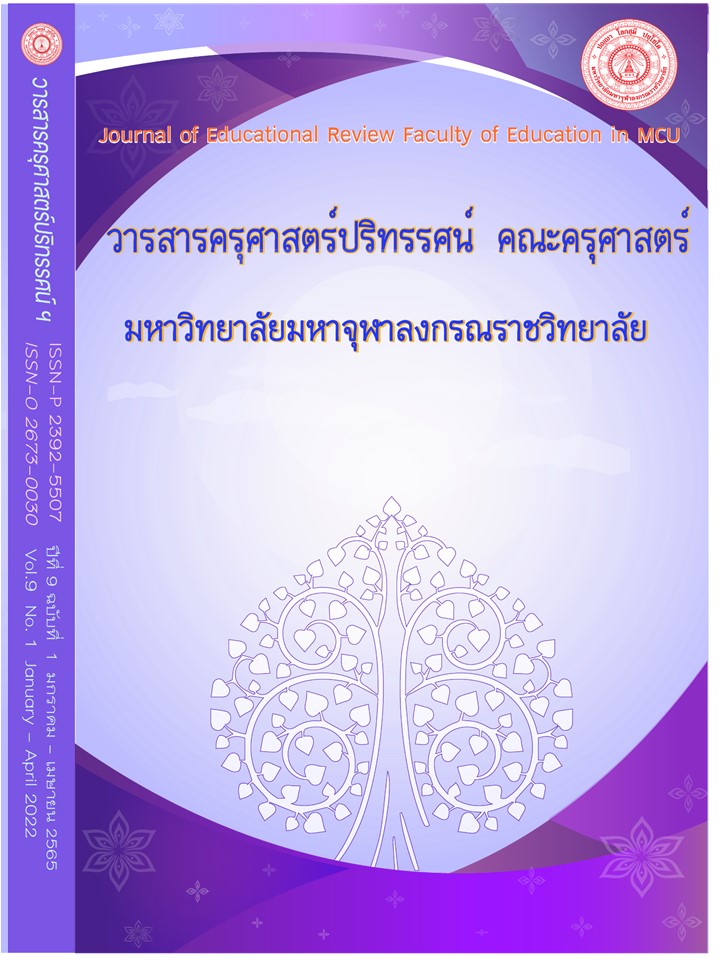A MODEL FOR CHINESE LANGUAGE LEARNING MANAGEMENT IN 21st CENTURY PRIVATE SCHOOLS IN SAMUT PRAKAN PROVINCE
Main Article Content
Abstract
The objectives of this research were to evaluate and improve the performance of Chinese Language Learning Management in the 21st century of private schools in Samut Prakan province. The research divides into four processes: 1) To study environment and method in managing Chinese Language Learning in 21st Century for private schools in Samut Prakan province; 2) To improve Chinese Language Learning Management in 21st Century for private schools in Samut Prakan province; 3) To evaluate the third process; 4) To implement the management system into the sample groups, which include Directors, Deputy Director of Academic Affairs, and Chinese teachers. The numbers of sample groups derive from Krejcie & Morgan's table, and the total number of 123 answerers is obtained by using Stratified Random Sampling. The research tools include questionnaires, interview forms, and satisfaction assessment forms. The data obtained were analyzed using basic statistics and content analysis. The result shows that 1) The overall Chinese Language Learning Management in 21st Century for private schools in Samut Prakan province is at a high level and 2) The result of the model development has two components. The first component consists of 8 aspects: (1) Chinese language curriculum, (2) Learning activity management, (3) Measurement and evaluation,
(4) Learning media/innovative information technology, (5) Organizing learning resources,
(6) Organizing learning atmosphere, (7) Developing thinking skills and the integration of knowledge into use, and (8) promotion of relations with the Chinese Teachers Association of each region. Next, the second model development component is the factors promoting Chinese learning management in the 21 st century. They are (1) teacher leadership development, (2) thinking skills for the future, (3) learning innovations, (4) developing professional teachers, and (5) competence satisfaction of the stakeholders and users' satisfaction with the management. Overall, the result is very high, and the model is feasible and valuable at the highest level.
Article Details

This work is licensed under a Creative Commons Attribution-NonCommercial-NoDerivatives 4.0 International License.
ทัศนะและความคิดเห็นที่ปรากฏในบทความในวารสารฉบับนี้ถือเป็นความรับผิดชอบของผู้เขียนบทความนั้นเพียงผู้เดียว และไม่ถือเป็นทัศนะและความรับผิดชอบของกองบรรณาธิการ
กองบรรณาธิการขอสงวนสิทธิ์ในการคัดเลือกบทความลงตีพิมพ์และจะแจ้งให้เจ้าของบทความทราบหลังจากผู้ประเมินบทความตรวจอ่านบทความแล้ว
ต้นฉบับที่ได้รับการตีพิมพ์ในวารสารครุศาสตร์ปริทรรศน์ คณะครุศาสตร์ มหาวิทยาลัยมหาจุฬาลงกรณราชวิทยาลัย ถือเป็นกรรมสิทธิ์ของคณะครุศาสตร์ มหาวิทยาลัยมหาจุฬาลงกรณราชวิทยาลัย ห้ามนำข้อความทั้งหมดหรือบางส่วนไปพิมพ์ซ้ำ เว้นเสียแต่ว่าจะได้รับอนุญาตจากมหาวิทยาลัยฯ เป็นลายลักษณ์อักษร
References
จันทรานี สงวนนาม. (2545). ทฤษฎีและแนวปฏิบัติในการบริหารสถานศึกษา. พิมพ์ครั้งที่ 2. กรุงเทพมหานคร: บุ๊คพอยท์.
จิรศักดิ์ สุภารส. (2559). การศึกษาการบริหารงานวิชาการตามหลกัธรรมาภิบาลของผู้บริหารโรงเรียนสังกัดสำนักงานเขตพื้นที่การศึกษาประถมศึกษาพระนครศรีอยุธยา เขต 2. วิทยานิพนธ์ครุศาสตรมหาบัณฑิต. มหาวิทยาลัยราชภัฏพระนครศรีอยุธยา.
ชลาลัย อานามวัฒน์. (2556). การบริหารการจัดการเรียนการสอนภาษาจีนของโรงเรียนเอกชนสอนภาษาจีน สังกัดสำนักงานคณะกรรมการส่งเสริมการศึกษาเอกชน ในกรุงเทพมหานคร. สารนิพนธ์การศึกษามหาบัณฑิต. มหาวิทยาลัยศรีนครินทรวิโรฒ.
พิมพันธ์ เดชะคุปต์ และพเยาว์ ยินดีสุข. (2558). การจัดการเรียนรู้แนวในทศวรรษที่ 21. พิมพ์ครั้งที่ 3. กรุงเทพฯ: โรงพิมพ์แห่งจุฬาลงกรณ์มหาวิทยาลัย.
ภิรักษ์สิทธิ์ เสนีย์วงค์ ณ อยุธยา. (2560). แนวทางการบริหารโรงเรียนสามภาษาในจังหวัดเชียงใหม่ สังกัดสำนักงานคณะกรรมการส่งเสริมการศึกษาเอกชน. วิทยานิพนธ์ครุศาสตรมหาบัณฑิต. มหาวิทยาลัยราชภัฏนครสวรรค์.
วรวิทย์ สุขะวัชรินทร์. (2556). การพัฒนารูปแบบการบริหารจัดการโรงเรียนเอกชนภาษาจีนในประเทศไทย. ดุษฎีนิพนธ์ปรัชญาดุษฎีบัณฑิต. มหาวิทยาลัยราชภัฏบ้านสมเด็จเจ้าพระยา.
วัชราภรณ์ วิจารณ์. (2550). การบริหารงานวิชาการในโรงเรียนเอกชนที่จัดการศึกษาขั้นพื้นฐาน สังกัดสำนักงานเขตพื้นที่การศึกษากาฬสินธุ์ เขต 2 ตามทัศนะของผู้บริหารโรงเรียนและครูผู้สอน. วิทยานิพนธ์ครุศาสตรมหาบัณฑิต. มหาวิทยาลัยราชภัฏมหาสารคาม.
วิจารณ์ พานิช. (2555). วิถีสร้างการเรียนรู้เพื่อศิษย์ในศตวรรษที่ 21. กรุงเทพมหานคร: มูลนิธิสดศรีสฤษดิ์วงศ์.
วิภาวรรณ สุนทรจามร. (2559). รายงานการวิจัยเพื่อพัฒนาระบบการจัดการเรียนการสอนภาษาจีนในประเทศ ระดับประถมศึกษา. รายงานการวิจัย. สำนักงานเลขาธิการสภาการศึกษา กระทรวงศึกษาธิการ.
ศศิณัฏฐ์ สรรคบุรานุรักษ์. (2560). สื่อมัลติมีเดียและเทคโนนโลยีกับการสอนภาษาจีนในศตวรรษที่ 21. E-Journal, Silpakorn University. 10(3). 1239-1256.
สถาบันระหว่างประเทศเพื่อการค้าและการพัฒนา. (2556). การพัฒนากลยุทธ์ การตลาดธุรกิจ แฟรนไชส์สู่สากลภายใต้โครงการพัฒนาและสร้างโอกาสทางการตลาด ธุรกิจแฟรนไชส์ ปี 2556. กรุงเทพมหานคร: กรมพัฒนาธุรกิจการค้า.
สำนักงานคณะกรรมการการศึกษาขั้นพื้นฐาน. (2555). นโยบายการส่งเสริมการจัดการศึกษาภาษาจีนในประเทศไทย. แหล่งที่มา www.thailocalmeet.com. สืบค้นเมื่อ 20 มี.ค. 2562.
สำนักงานคณะกรรมการพัฒนาการเศรษฐกิจและสังคมแห่งชาติ. (2560). แผนพัฒนาเศรษฐกิจและสังคมแห่งชาติ ฉบับที่สิบสอง พ.ศ. 2560 – 2564. แหล่งที่มา www.thailocalmeet.com. สืบค้นเมื่อ 20 มี.ค. 2562.
สุเทพ ตระหง่าน. (2559). รูปแบบการบริหารงานวิชาการในสถานศึกษาสังกัดสำนักงานคณะกรรมการการ ส่งเสริมการศึกษาเอกชน. วารสารวิชาการมหาวิทยาลัยปทุมธานี. 8(2). 157-172.
ฐิติกาญจน์ คงชัย และกาญจนา บุญส่ง. (2560). ปัจจัยที่ส่งผลต่อคุณภาพการปฏิบัติงานของครูในศตวรรษที่ 21 ของสถานศึกษาในจังหวัดเพชรบุรี สังกัดสำนักงานคณะกรรมการการอาชีวศึกษา. Veridian E-Journal, Silpakorn University. 10(2). 351-364.
Keeves, Peter J. (1988). Model and Model Building: Educational Research Methodology and Measurenment : An Intermational Handbook. Oxford: Pergamon Press.
Krejcie, R. V., & Morgan, D. W. (1970). Determining sample size for research activities. Educational and Psychological Measurement. 30(3). 607–610.


